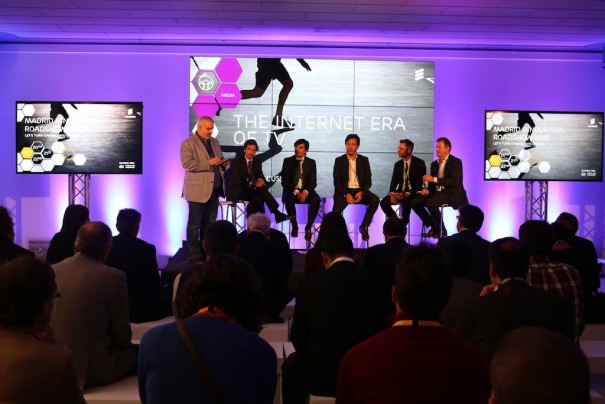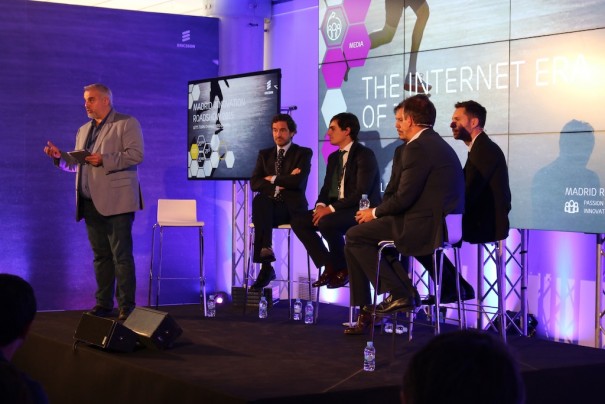Broadcasters y telcos analizan los retos tecnológicos y operativos de la nueva televisión
Representantes de Atresmedia, Mediaset, Telefónica y Vodafone debaten en el Ericsson Innovation Roadshow 2015 sobre los retos que plantea la convergencia entre televisión e Internet.
He Ericsson Innovation Roadshow 2015, que se celebra del 20 al 22 de octubre en el centro I+D que tiene la multinacional sueca en Madrid, ha incluido en su extensa programación una mesa redonda en la que se ha analizado la convergencia entre televisión e Internet.
Internet y los llamados servicios y aplicaciones OTT están cambiando la tradicional cadena de valor que une los contenidos con su audiencia. Además, en este nuevo ecosistema de media, mucho más dinámico, están apareciendo nuevos entrantes con sus respectivos acuerdos, fusiones y adquisiciones. En la mente de todos ellos se da un objetivo común: estar más cerca de la audiencia y conocerla mejor.
La oportunidad está presente. El consumo de TV crece y el consumidor tiene nuevas aplicaciones y experiencias digitales disponibles en lo que algunos ya están calificando como la nueva época dorada de la televisión.
Para debatir sobre ello, Ericsson ha invitado a Ignacio Fernández-Vega, director de Movistar+ (Telefónica); José Miguel García-Gascó, director general de Atresmedia Publicidad; Ignacio García-Legaz, director de Vodafone Tv; Orlando Gutiérrez, al frente del estudio de las nuevas formas de comunicación en PubliEspaña (Mediaset España); y Chema Casaos, director de Soluciones y Servicios de Televisión en Ericsson Iberia. Antonio Castillo, director de Panorama Audiovisual, ha sido el encargado de moderar esta mesa.
Fernández-Vega ha iniciado su intervención asegurando que los objetivos de Telefónica desde el lanzamiento de Imagenio y ahora con la plataforma Movistar+ han sido “mejorar la calidad y la oferta de contenidos. Todo siempre pivota sobre algo muy básico: el contenido. Somos cada vez más agnósticos a la tecnología poniendo más foco en ofrecer el contenido de forma amigable a los clientes”.
García-Gascó ha señalado que el nuevo panorama está marcado “por la aparición por derecha y por izquierda de nuevos players que hasta ahora eran nuestros inversores publicitarios, y ahora intentan restarte cuota. En este contexto, sobre todo hay que valorar el producto que quiere el espectador. Tenemos que ofrecer no solo buen contenido tanto en el televisor como fuera de él. La batalla realmente es por la televisión y no puede circunscribirse solo al televisor. Tenemos que buscar la atención del espectador. Por ello, es primordial generar algo relevante… que le atraiga. Ha evolucionado el consumo a uno más tecnológico con capacidades de grabación, multidispositivo… y con nuevos agentes, pero la batalla está en el contenido”.
Ignacio García-Legaz reconoce que “está cambiando el consumidor, la cadena de valor, la tecnología, las ventanas, los derechos.. y se han habilitado nuevas formas de llevar contenidos a los consumidores. Parte de estos cambios vienen del mundo de Internet. Nuestro posicionamiento es ser un operador de televisión tradicional, llevar al consumidor la mejor propuesta desde una experiencia integrada. Queremos que en todo el proceso de consumo cómo interactúen con su proveedor de servicios ya sea a través de Internet, mobile o televisión sea muy relevante su satisfacción. Es clave que su experiencia sea buena y podamos ofrecerle contenidos atractivos. Nuestro objetivo en Vodafone Tv pasa por buscar los mejores contenidos del mercado y llevarlos de forma sencilla al usuario”.
Orlando Gutiérrez ha reflexionado sobre cómo está cambiando el análisis de audiencias. “El consumo debe ser siempre un todo con independencia de que se vea en lineal, diferido, streaming online, a la carta. Nos encontramos con un mercado de tv tradicional con grandes coberturas, que persistirá, a la par que surge un nuevo mercado del data, con consumos fuera de la televisión lineal que nos permite conocer al usuario, segmentar la publicidad. Este entorno actuará como un complemento al mercado de televisiones convencional. Ambos conviven y se necesitan uno del otro”, ha señalado.
“El consumo de la televisión lineal no se ha resentido, en septiembre fue el mismo que en el año pasado (tres horas y tres cuartos al día), incluso en los jóvenes de 16 a 34 años… Podemos hablar de una tv enriquecida porque el consumo crece y le aporta datos que la tv tradicional no tenía”, ha añadido.
Gutiérrez ha puesto el ejemplo de un programa como Mujeres, hombres y vicevera, muy popular entre los millennials, donde tras el repunte de audiencia en la emisión lineal, el consumo se retoma en diferido con una curva muy levada a lo largo de todo el día. “Hay programas que su audiencia no lineal alcanza un peso de entre el 10-12% sobre el total”, ha asegurado.
Chema Casaos ha aportado la visión de un proveedor tecnológico como Ericsson. “Nuestra visión de la televisión es dentro de una sociedad conectada. Intentamos ayudar a unir contenidos con audiencias. Las plataformas tradicional de broadcast permite una calidad en directo, pero Internet complementa esos consumos aunque plantea una gran complejidad técnica. Por eso nuestro enfoque es ayudamos a los player a trabajar en este nuevo entorno. Queremos que ese consumo llegue con calidad suficiente para que el negocio funcione. Estas plataformas las complementamos con soluciones de analítica ya que quieren estar más cerca del consumidor con una mejor experiencia de usuario”, ha subrayado.
Sobre la posibilidad de desarrollar contenidos propios como están haciendo plataformas como Netflix, que esta semana aterriza en España, Fernández-Vega no concibe un servicio sin producción propia. “Aunque tenemos un ingente catálogo que en VoD premium puede llegar a más de 15.00 títulos, nos falta el complemento de la producción propia. La producción propia es una cuestión de diferenciación del producto. De forma aún muy modesta hemos llevado a cabo primeras experiencias con la coproducción de cine y alguna serie a través de Telefónica Studios. En breve esperamos contar con producciones 100% de Telefónica tanto para España como para Latinoamérica. Es uno de los retos que tenemos las telco”.
Sin embargo, para García-Legaz la producción propia no es indispensable: “el operador puede decidir ir o no ir. En nuestro caso, estamos orientados a España y es un mercado pequeño como para abordar producciones de calidad a esta escala. Por ello, apostamos por contratos con majors, productoras y broadcasters para contar con producciones de la más alta calidad. Para las telco entrar en producción propia necesita un expertise muy elevado. Preferimos llegar a acuerdos con los especialistas en producción para hacerle llegar al consumidor los mejores contenidos”.
Contenidos y tecnología
A juicio de García-Gascó, “contenidos y tecnología es la fórmula para fidelizar y generar una experiencia en el usuario. Soy abanderado de la televisión como la conocemos hoy. Resulta curioso comprobar cómo entre el 50-60% del share de un hogar que cuentan con plataforma de pago se aglutina en emisiones de broadcasters tradicionales. Necesitamos que haya mucha gente delante del televisor para lograr gran cobertura… no solo los programas en directo o deportivos pueden generar fidelización… sino todo aquello que sea relevante socialmente. Esa capacidad de generar eventos explotables comercialmente solo la tenemos los broadcatsers.
Tenemos que trabajar en mejorar la experiencia y conocer mejor a nuestro usuario. Le doy larga vida a la televisión porque satisface a muchos públicos…”
Sobre cómo el big data ayudará a mejorar los hábitos de los consumidores, Orlando Gutiérrez entiende que permite, por un lado, un mayor conocimiento del usuario, y por otro, la automatización de los procesos de venta, sobre todo con la famosa venta programática y los sistemas de Real Time Biding. Sin embargo, paralelamente crecen alternativas de Ad Block que permiten bloquear el envío del mensaje publicitario… A juicio de Gutiérrez, “los productos premium mejoran las conversiones, el CTR… el reto quizás sea no solo segmentar sino crear valor añadido adecuado a cada uno de los usuarios. Por eso es necesario conocerlo a fondo para evitar un bombardeo inncesario de impactos”.
Chema Casaos ha destacado que este nuevo entorno “requiere de retos tecnológicos y operativos. El estudio Consumer Lab prevé que en 2020 el 90% de la población estará conectada y el 70% tendrá un smartphone. Esto hará crecer el consumo de contenidos. La generalización de la banda ancha, tanto en fibra como en 4G, ayudará a que exista una más penetración mayor en diferentes formas de consumo. Y, por supuesto, el cloud jugará un papel clave”
Partiendo del concepto de que el 60% de la población, según el INE, vive en poblaciones de menos de 100.000 habitantes y, de ellos, un 13% reside en municipios con menos de 5.000 vecinos, y que la fibra directa al hogar supera el millón de líneas en grandes ciudades… ¿qué panorama le espera a la IPTV desde el punto de vista de la universalización del acceso al servicio?
El director de Movistar+ cree en la “combinación del satélite con el par de cobre para contar con interactividad y complementar la oferta. Nos gustaría llegar al 100% con fibra pero eso no es posible por lo que hay que buscar fórmulas complementarias. Bien con la red 4G o híbrida con satélite podemos ofrecer una solución adecuada al cliente para que reciba una oferta sencilla. No podemos trasladar al clientes nuestros problemas… Nuestra obligación es que acceda a una oferta de servicios de forma lo más sencilla posible”.
En línea al análisis de la televisión híbrida, el director de Atresmedia Publicidad reconoce que la “TDT híbrida es un área en el que trabajar de cara a que podamos mandar un mensaje y recibir información de cómo se consume. Estamos trabajando para comprobar si el HbbTv es una solución de competencia o por el contrario nos servirá para enriquecer contenidos. Tendremos más noticias sobre televisión híbrida en los próximos meses”.
Esta mesa de debate también se ha detenido sobre un aspecto clave: la concurrencia. “Internet presenta muchas ventajas para muchas cosas, pero el servicio de televisión tiene particularidades. La concurrencia en grandes eventos es una de ellas. Facilitar que broadcasters y operadores se olviden de la tecnología es para lo que trabajamos en Ericsson. El delivery debe hacerse con calidad teniendo en cuenta aspectos como la concurrencia para garantizar en todo momento la calidad al usuario”, ha comentado Casaos.
Por último, los expertos han analizado el impacto de la piratería en estos nuevos modelo de negocio.
García-Legaz reconoce que “la piratería nos afecta a todos. Tenemos que seguir trabajando tanto a nivel operativo, regulatorio, de seguridad… para reducir el impacto. Hay experiencia en otros mercados en los que con una alta tasa de piratería, cuando existen ofertas de propuestas valor a precio razonable y una experiencia buena, la piratería se reduce”. Por su parte, Ignacio Fernández-Vega ha sido tajante: “una baja de precio no significa un descenso en la piratería. Sin embargo, una oferta interesante… sí”.
[youtube]https://www.youtube.com/watch?v=HgzEy_SUfk4[/youtube]
Did you like this article?
Subscribe to our NEWSLETTER and you won't miss anything.





